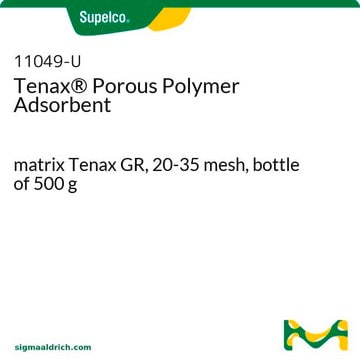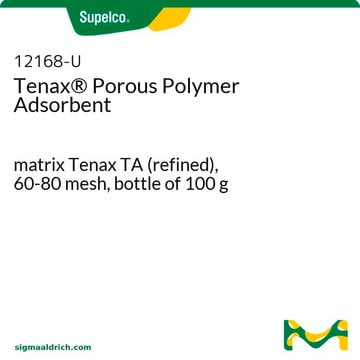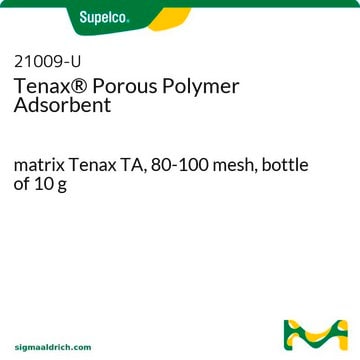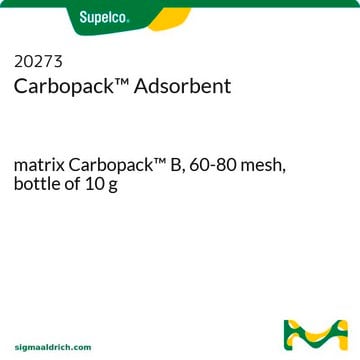Products may be shipped at a different temperature than the recommended long-term storage temperature. If the product quality is sensitive to short-term exposure to conditions other than the recommended long-term storage, it will be shipped on wet or dry-ice. If the product quality is NOT affected by short-term exposure to conditions other than the recommended long-term storage, it will be shipped at ambient temperature. As shipping routes are configured for minimum transit times, shipping at ambient temperature helps control shipping costs for our customers. For more information, please refer to the Storage and Transport Conditions document: https://www.sigmaaldrich.com/deepweb/assets/sigmaaldrich/marketing/global/documents/316/622/storage-transport-conditions-mk.pdf
11982
Polímero poroso adsorvente Tenax®
matrix Tenax TA, 60-80 mesh, bottle of 10g
About This Item
Produtos recomendados
Nome do produto
Polímero poroso adsorvente Tenax®, matrix Tenax TA, 60-80 mesh, bottle of 10 g
Agency
suitable for EPA 601
Formulário
solid
embalagem
bottle of 10 g
Parâmetros
350 °C temp. limit
área da superfície
~35 m2/g
Matriz
Tenax TA
tamanho de partícula
60-80 mesh
densidade
~0.25 g/mL (free fall density)
Procurando produtos similares? Visita Guia de comparação de produtos
Categorias relacionadas
Descrição geral
Para obter mais informações sobre qualquer um dos nossos adsorventes, visite sigma-aldrich.com/adsorbents
Aplicação
- compostos orgânicos voláteis (COVs) em microambientes diferentes antes de sua determinação por dessorção térmica (DT) de trajeto curto (do inglês, SPTD) e cromatografia gasosa/espectrometria de massa (GC-MS).[1]
- Hidrocarbonetos C7-C26 em amostras de ar ambiente[2] e COVs em amostras de ar de salas de trabalho[3] antes da análise por DT seguida de análise por GC.
Informações legais
Palavra indicadora
Warning
Frases de perigo
Declarações de precaução
Classificações de perigo
Eye Irrit. 2 - Skin Irrit. 2 - STOT SE 3
Órgãos-alvo
Respiratory system
Código de classe de armazenamento
11 - Combustible Solids
Classe de risco de água (WGK)
WGK 3
Ponto de fulgor (°F)
Not applicable
Ponto de fulgor (°C)
Not applicable
Equipamento de proteção individual
dust mask type N95 (US), Eyeshields, Gloves
Escolha uma das versões mais recentes:
Certificados de análise (COA)
It looks like we've run into a problem, but you can still download Certificates of Analysis from our Documentos section.
Se precisar de ajuda, entre em contato Atendimento ao cliente
Já possui este produto?
Encontre a documentação dos produtos que você adquiriu recentemente na biblioteca de documentos.
Os clientes também visualizaram
Conteúdo relacionado
This page is intended to make it easier to find the consumables you need based on the analytical method you’re using. Methods included on this page come from the EPA, Standard Methods and ASTM.
-
How is shipping temperature determined? And how is it related to the product storage temperature?
1 answer-
Helpful?
-
-
How can I determine the shelf life / expiration / retest date of this product?
1 answer-
If this product has an expiration or retest date, it will be shown on the Certificate of Analysis (COA, CofA). If there is no retest or expiration date listed on the product's COA, we do not have suitable stability data to determine a shelf life. For these products, the only date on the COA will be the release date; a retest, expiration, or use-by-date will not be displayed.
For all products, we recommend handling per defined conditions as printed in our product literature and website product descriptions. We recommend that products should be routinely inspected by customers to ensure they perform as expected.
For products without retest or expiration dates, our standard warranty of 1 year from the date of shipment is applicable.
For more information, please refer to the Product Dating Information document: https://www.sigmaaldrich.com/deepweb/assets/sigmaaldrich/marketing/global/documents/449/386/product-dating-information-mk.pdfHelpful?
-
-
Can tenax be restored in laboratory oven at 40 *C temperature?
1 answer-
The Tenax® Porous Polymer Adsorbent can be regenerated by hot-methanol extraction.
Helpful?
-
-
What is the Department of Transportation shipping information for this product?
1 answer-
Transportation information can be found in Section 14 of the product's (M)SDS.To access the shipping information for this material, use the link on the product detail page for the product.
Helpful?
-
-
What solvents can be used for chemical desorption for Product No. 11982, Tenax TA 60-80 mesh?
1 answer-
Common solvents like alcohols, ethers, hydrocarbons, and aqueous hydrochloric acid/sodium hydroxide can be used. Don't use chlorinated hydrocarbons like dichloromethane, aromatics like xylene and carbon disulfide. All other solvents not mentioned can be used after checking solubility.
Helpful?
-
Active Filters
Nossa equipe de cientistas tem experiência em todas as áreas de pesquisa, incluindo Life Sciences, ciência de materiais, síntese química, cromatografia, química analítica e muitas outras.
Entre em contato com a assistência técnica











